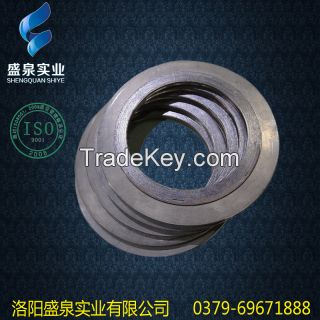Description
SPIRAL WOUND GASKETS
Â
Spiral wound gasket is formed by preloading with corrugated metal
and nonmetal with alternating overlapping spiral wound made, and
add reinforcement ring according to working conditions. Because it
has multi-channel sealing, high temperature, corrosion-resistant,
less demanding on the flange sealing surface roughness and other
characteristics, so it is widely used in power stations, aviation,
petrochemical, valves and other industries.
Medium: steam, hydrogen, natural gas, pyrolysis gas, oil, acid,
alkali, salt solutions, etc.
Â
Benefits:
1, spiral wound gasket has good compression rate and
resilience.
2, spiral wound gasket with the appropriate plasticity, after
pressing the sealing surface can adapt to uneven sealing surface
and fill the gap, in order to ensure good sealing performance in
case of a system of alternating temperature and pressure.
3, spiral wound gasket has good tensile strength and
elongation.
4, spiral wound gasket has excellent corrosion resistance, it will
not be destroyed in some extreme medium, does not produce a large
expansion and contraction.
5, spiral wound gasket does not soften at high temperatures, do not
creep; non-hardening at low temperatures, does not shrink.
6, spiral wound gasket with sufficient strength, under external
loading conditions, not to be crushed; under high pressure, not to
be blown out.
Â
YDAJ basic mode
Consists of a metal belt and filling material wrapped, applicable
to the concave and convex flanges, mortise flange and groove
flange.
YDBJ ring
The addition of the metal inner ring on the basic type as the
pressure retaining body, also fill the flange and sealing of the
inner edge of the air
Gap, the design can prevent the solid accumulation, reduce fluid
impact, and make the flange surface erosion to minimize.
YDC type outer ring
Using the outer ring, the gasket can be placed in the center of the
flange accurately, well provide additional stress to prevent the
gasket burst, into
A compression check point. Generally applicable to the plane and
raised face flanges.
YDD type of inner and outer ring
Add in the inner outer ring based on internal compression as a
stopping point, also be resistance body heat and corrosion,
protection
The pad plate sealing surface of flange, to prevent corrosion.
Suitable for the plane and raised face flanges, especially in high
temperature and high pressure work conditions.
Â
Â
Â
Â
Â
Metal material temperature table
 |
|
Material |
           Â
Min
   Â
℉        Â
℃ |
        Â
Max
  Â
℉        Â
℃ |
 Abbreviation
 Â
 mark |
|
 **4SS |
***0 |
***5 |
***0 |
**0 |
**4 |
|
 **6LSS |
***0 |
***0 |
***0 |
**0 |
**6L |
|
 **1SS |
***0 |
***5 |
***0 |
**0 |
**1 |
|
 **7SS |
***0 |
***5 |
***0 |
**5 |
**7 |
|
  WCB |
**0 |
**0 |
**0 |
**0 |
CRS |
|
 *0 Cb*3(Alloy) |
***0 |
***5 |
***0 |
**0 |
A**0 |
|
  HASTELLOYB2 |
***0 |
***5 |
***0 |
***0 |
HASTB |
|
 HASTELLOYC**6 |
***0 |
***5 |
***0 |
***0 |
HASTC |
|
 INCOLOY**0 |
***0 |
***0 |
***0 |
**0 |
In**0 |
|
 INCONEI**0 |
***0 |
***0 |
***0 |
***0 |
INC**0 |
|
 INCONEL×**0 |
***0 |
***0 |
***0 |
***0 |
INX |
|
 MONEL**0 |
***0 |
***0 |
***0 |
**0 |
MON |
|
  Nickel **0 |
***0 |
***5 |
***0 |
**0 |
Ni |
|
  Titanium |
***0 |
***5 |
***0 |
***0 |
Ti |
Â
Filling
material temperature resistance performance
table
 |
|
Material |
      Â
Min
  Â
℉     ℃ |
      Â
Max
   ℉    Â
℃ |
Abbreviation  Â
 mark |
|
Ceramic |
***0 |
***2 |
***0 |
***0 |
CER |
|
Flexible graphite |
***0 |
***2 |
**0 |
**0 |
 F.G. |
|
Teflon |
***0 |
***0 |
**0 |
**0 |
PTEE |
|
Asbestos |
***4 |
***8 |
***2 |
**0 |
ASB |
|
Non asbestos |
***4 |
***0 |
**2 |
**0 |
TNA |
Â
